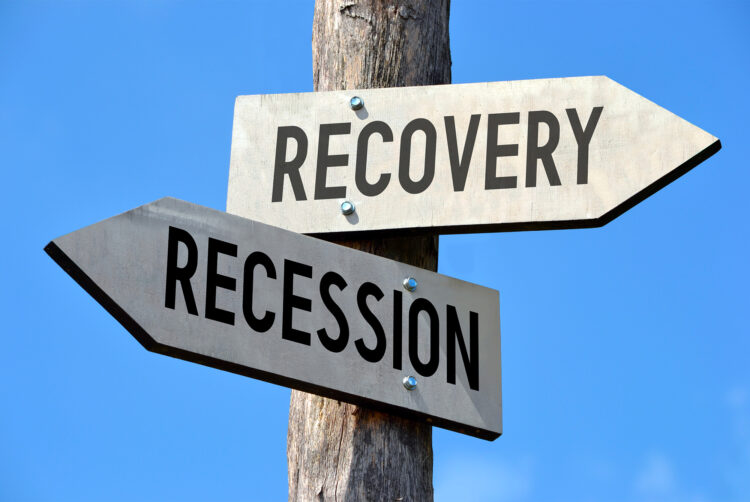Why you must focus on the recovery when advertising in a downturn

Opinion
The first thing all agencies should be saying to their clients is: hold your nerve.
On 7 June the World Bank slashed its global growth forecast to 2.9% for 2022. The bank warned that the world economy could slip into a period of stagflation reminiscent of the 1970s, saying that “for many countries, recession will be hard to avoid”.
The next day The British Chambers of Commerce downgraded its expectations for UK GDP growth for 2022 to 3.5%, from 3.6%, against a deteriorating economic outlook. It said annual UK economic growth is expected to slow sharply to 0.6% for 2023, only recovering slightly to 1.2% in 2024.
As we come out of what has been a very hard couple of pandemic years, we are now experiencing a perfect storm of negative economic and geo-political conditions – led by the energy crisis and Ukraine – forcing us into economic downturn and possibly recession. And so, once again, the industry is wrestling with how to deal with significant pressure on budgets and assessing what it’s likely to mean for marketing strategy and advertising spend.
The IPA/Opinium spoke to 2,000 consumers to assess how brands should best support them as the cost-of-living crisis worsens. The most popular ways were: keeping prices fair, price freezes of value-for-money products, more value-for-money promotions and greater rewards for loyalty.
The findings are not surprising and frankly serve to reinforce the seriousness of the crisis – especially amongst older generations – and they focus the need for brands to be on point with the mood of the nation. However, brands should be wary of short-term promotional strategies which can lead to consumer dependency and, ultimately, loss of profit. While the current reality may seem harsh and scary, we have been here before, and so as an industry we need to learn from the mistakes of the past and build on the smart thinking that has evolved from previous situations of adversity.
Maintain focus but assess how you spend
The first thing all agencies should be saying to their clients is: hold your nerve. There will be immense pressure over the coming weeks to cut brand activity in favour of short-term ROI solutions – those brands that can resist this may take a short term hit in profitability during the downturn, but will show much stronger growth in recovery. It really doesn’t pay to ‘go dark’. It’s a blunt tool that carries a high risk of share loss, an expected five-year recovery period and significant loss of profit when markets return to ‘normal’.
One of the key benefits of continuing to advertise in a downturn is the extra share of voice (ESOV).
Smart marketers use periods of economic pressure and uncertainty to build brands more cheaply as their competitors scale back on marketing to save money. ESOV is widely validated as a key driver of effectiveness. Brands that invest in SOV during a recession have been shown to benefit from startling results. According to the IPA’s Advertising in Recession – Long, Short or Dark, these include: 4.5x annual marketshare growth, 5x very large business effects versus under-investors, widespread strong profitability growth in recovery versus none for under-investors, and the benefits of investment grow more strongly during recession compared to normal times.
And it’s not just about continuing to spend, but how you spend. Getting the balance right between brand and product/service is critical (50/50 is the perceived wisdom). Unless survival depends on servicing existing customers, brands should maintain a focus on brand building and work this in tandem with response investment.
Then, it’s about smart use of media. Clearly, brands should be smart with the media all the time, but a downturn focuses even greater attention on this. In terms of online, I would advise looking to addressable media for affordability, SOV and maintaining ROI.
An affordable results-based approach
Advertisers that invest in addressable media – typically Facebook and Google – benefit from precision targeting, low wastage and highly measurable campaigns. By combining addressable media with different types of data – demographic and other personal information – it is now much easier to target individuals at a national, regional or hyper-local level. And simple and affordable addressable advertising solutions are now more widely available across TV, video-on-demand, mobile, out-of-home and radio.
During tough times, brands can ‘play it safe’ with more easily measurable online media, particularly those in performance marketing. Social media can deliver scale for lower capital costs than other more ‘traditional’ media channels. And there’s the added advantage of frequency reporting in the social space, so brand advertisers can measure reach and frequency.
In a downturn, online video – whether YouTube, social platforms or via DSPs – can be used to manage costs effectively and to target audiences that are harder to reach via TV. Using Dynamic Creative Optimisation, return on adspend (ROAS) can be improved, and attention maximised, on personalised level at scale. This is an affordable scientific and results-based approach that matches different creatives with different audiences. Successful content programmes using this approach could improve ROAS by as much as 24% (Silence Media/Wavemaker).
Clearly, online environments won’t be exempt from cost increases brought on by greater competition – CPMs, cost per clicks (CPCs) and cost per views (CPVs) will be driven up as more advertisers enter auctions. The quality of impression in video environments also carry less impact than traditional TV, so brand awareness levels can drop. Advertisers simply need to be prepared for this and to factor it into their planning and ROI expectations.
In terms of smart use of offline media, extra value can be gleaned from more brand-led traditional channels, where unsold inventory can be secured at cheaper prices. In 2020, there was 43% less entertainment & leisure adspend vs 2019 (Nielsen) which, on some channels, led to heavy double-digit discounts.
Defend your share of voice
Coming late to market will be advantageous. Holding a percentage of budget back for short-term buys will maximise cost efficiencies and please CFOs! Advertisers should consider 10%-15% of budget, depending on business sector, objectives and KPIs.
Cash will continue to be king, especially during these higher inflationary times. Advertisers that don’t have good working capital in their business, should look to negotiate early payment discounts or other forms of added value.
Advertisers under pressure to reduce national spend should consider geo-targeting options. Follow customer data and zero in on potential hotspots targeted via addressable media channels. This will save capital cost, improve ROI through narrowcast targeting and provide evidence-based results through exposed/non exposed area analysis.
As the IPA makes clear, don’t throw away a good brand campaign in favour of short termism. Defend your share of voice, as there is a strong relationship between SOV and stable market share. Seize your market opportunity – the cost of SOV falls during recession and there will be opportunities for lower-cost growth than during normal times.
Consider addressable media channels to maintain a presence and engage with audiences with costs that needn’t break the bank. Innovate through affordable new technologies that can improve ROAS and deliver tangible results.
And, remember, advertising benefit is for the recovery not the recession.
 David Price is managing Director at independent media agency The Grove Media
David Price is managing Director at independent media agency The Grove Media




